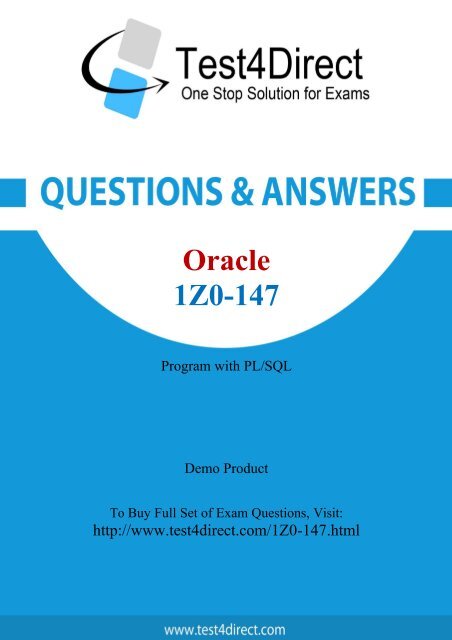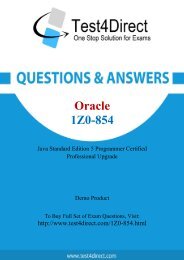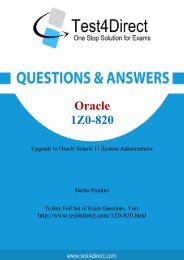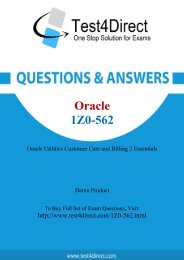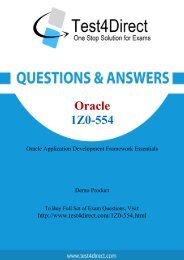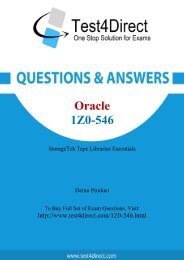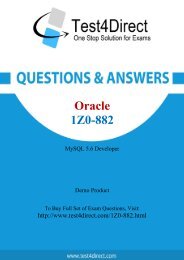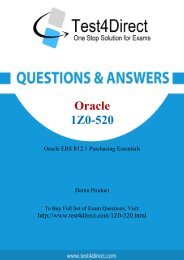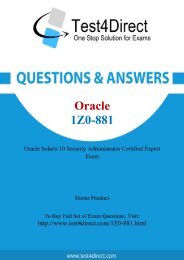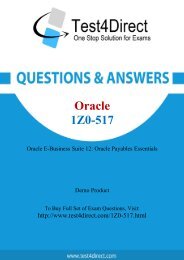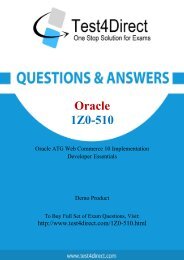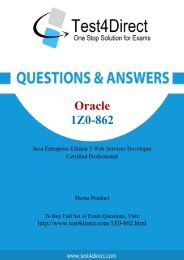Up-to-Date 1Z0-147 Exam BrainDumps for Guaranteed Success
Test4Direct provides latest PDF questions of Oracle 1Z0-147 exam. You have an opportunity to pass the Oracle 1Z0-147 exam in one go. Test4Direct is most accurate source to prepare Oracle 1Z0-147 exam as your success will become site’s responsibility after purchasing 1Z0-147 exam product. There are also lots of discounts and promotion offers that you can avail. Let’s try a free demo http://www.test4direct.com/1Z0-147.html
Test4Direct provides latest PDF questions of Oracle 1Z0-147 exam. You have an opportunity to pass the Oracle 1Z0-147 exam in one go. Test4Direct is most accurate source to prepare Oracle 1Z0-147 exam as your success will become site’s responsibility after purchasing 1Z0-147 exam product. There are also lots of discounts and promotion offers that you can avail. Let’s try a free demo http://www.test4direct.com/1Z0-147.html
Create successful ePaper yourself
Turn your PDF publications into a flip-book with our unique Google optimized e-Paper software.
Oracle<br />
<strong>1Z0</strong>-<strong>147</strong><br />
Program with PL/SQL<br />
Demo Product<br />
To Buy Full Set of <strong>Exam</strong> Questions, Visit:<br />
http://www.test4direct.com/<strong>1Z0</strong>-<strong>147</strong>.html
Question: 1<br />
<strong>Exam</strong>ine this function:<br />
CREATE OR REPLACE FUNCTION CALC_PLAYER_AVG<br />
(V_ID in PLAYER_BAT_STAT.PLAYER_ID%TYPE)<br />
RETURN NUMBER<br />
IS<br />
V_AVG NUMBER;<br />
BEGIN<br />
SELECT HITS / AT_BATS<br />
INTO V_AVG<br />
FROM PLAYER_BAT_STAT<br />
WHERE PLAYER_ID = V_ID;<br />
RETURN (V_AVG);<br />
END;<br />
Which statement will successfully invoke this function in SQL *Plus?<br />
A. SELECT CALC_PLAYER_AVG(PLAYER_ID)<br />
FROM PLAYER_BAT_STAT;<br />
B. EXECUTE CALC_PLAYER_AVG(31);<br />
C. CALC_PLAYER('RUTH');<br />
D. CALC_PLAYER_AVG(31);<br />
E. START CALC_PLAYER_AVG(31)<br />
Answer: A<br />
Explanation:<br />
A function can be invoked in SELECT Statement provided that the function does not modify any<br />
database tables. The function must use positional notation <strong>to</strong> pass values <strong>to</strong> the <strong>for</strong>mal parameters.<br />
The <strong>for</strong>mal parameters must be of the IN mode. They should return data types acceptable <strong>to</strong> SQL and<br />
they should not include any transaction, session, or system control statements.<br />
Incorrect Answers:<br />
B: You can't call a function in this way, in this way you can call a procedure, because function must<br />
return a value, <strong>to</strong> call a function using EXECUTE command you should declare a bind variable using<br />
the VARIABLE command then assign the value returned from the function <strong>to</strong> this variable, in the<br />
following way:SQL> VARIABLE v_get_value NUMBERSQL><br />
C: v_get_value := CALC_PLAYER_AVG(31)PL/SQL procedure successfully completed.SQL><br />
PRINT v_get_valueV_GET_VALUE----------- 1<br />
Again this way can't be use <strong>for</strong> calling a function in PL/SQL block because the function return a value<br />
and this values must be assigned <strong>to</strong> PL/SQL variable or <strong>to</strong> bind variable. Like this DECLARE<br />
v_get_from_fn NUMBER; BEGIN v_get_from := CALC_PLAYER_AVG(31); END; /<br />
D: Same as C.<br />
E: v_get_value := CALC_PLAYER_AVG(31)PL/SQL procedure successfully completed.SQL><br />
PRINT v_get_valueV_GET_VALUE----------- 1<br />
v_get_value := CALC_PLAYER_AVG(31)PL/SQL procedure successfully completed.SQL> PRINT<br />
v_get_valueV_GET_VALUE----------- 1<br />
v_get_value := CALC_PLAYER_AVG(31)PL/SQL procedure successfully completed.SQL> PRINT
v_get_valueV_GET_VALUE----------- 1<br />
START is use <strong>to</strong> execute a script.<br />
Question: 2<br />
Which three are true statements about dependent objects? (Choose three)<br />
A. Invalid objects cannot be described.<br />
B. An object with status of invalid cannot be a referenced object.<br />
C. The Oracle server au<strong>to</strong>matically records dependencies among objects.<br />
D. All schema objects have a status that is recorded in the data dictionary.<br />
E. You can view whether an object is valid or invalid in the USER_STATUS data dictionary view.<br />
F. You can view whether an object is valid or invalid in the USER_OBJECTS data dictionary view.<br />
Explanation:<br />
Incorrect answers: B, D, E<br />
Question: 3<br />
Answer: A,C,F<br />
You have created a s<strong>to</strong>red procedure DELETE_TEMP_TABLE that uses dynamic SQL <strong>to</strong> remove a table<br />
in your schema. You have granted the EXECUTE privilege <strong>to</strong> user A on this procedure. When user A<br />
executes the DELETE_TEMP_TABLE procedure, under whose privileges are the operations per<strong>for</strong>med<br />
by default?<br />
A. SYS privileges<br />
B. Your privileges<br />
C. Public privileges<br />
D. User A's privileges<br />
E. User A cannot execute your procedure that has dynamic SQL.<br />
Answer: B<br />
Explanation:<br />
When you create a procedure, it will be executed under the privileges of the crea<strong>to</strong>r, unless the<br />
procedure has the following statement AUTHID CURRENT_USER. If you specify AUTHID<br />
CURRENT_USER, the privileges of the current user are checked at run time, and external references<br />
are resolved in the schema of the current user. Like this example SQL> CREATE OR REPLACE<br />
PROCEDURE delete_temp_table ( v_table varchar2)<br />
2 AUTHID CURRENT_USER<br />
3 IS<br />
4 BEGIN<br />
5 EXECUTE IMMEDIATE 'DROP TABLE '||V_TABLE;<br />
6 END;<br />
7 /<br />
Procedure created.<br />
If the procedure is create in this way then the EXECUTE IMMEDIATE statement will be execute under<br />
the privilege of the user who executes the procedure, but if we skip line 2 then the procedure will be<br />
executed under the privilege of the owner of the procedure.
Incorrect Answers:<br />
A: SYS privilege has nothing with is.<br />
C: What is the public privileges? There is nothing called public privileges.<br />
D: This will be true if the procedure contains the AUTHID CURRENT_USER.<br />
E: There is no problem in having a dynamic SQL statement in Procedure.<br />
Question: 4<br />
<strong>Exam</strong>ine this code:<br />
CREATE OR REPLACE PRODECURE add_dept<br />
(p_dept_name VARCHAR2 DEFAULT 'placeholder',<br />
p_location VARCHAR2 DEFAULT 'Bos<strong>to</strong>n')<br />
IS<br />
BEGIN<br />
INSERT INTO departments<br />
VALUES (dept_id_seq.NEXTVAL, p_dept_name, p_location);<br />
END add_dept;<br />
/<br />
Which three are valid calls <strong>to</strong> the add_depprocedure? (Choose three)<br />
A. add_dept;<br />
B. add_dept('Accounting');<br />
C. add_dept(, 'New York');<br />
D. add_dept(p_location=>'New York');<br />
Question: 5<br />
Answer: A,B,D<br />
Explanation:<br />
A is correct because both of the parameter have a default values. B is correct because here we call<br />
the procedure using position notation, and the first parameter <strong>for</strong> the procedure will have the value<br />
'Accounting ', and since the second parameter has a default value then we can skip it, and in this case<br />
it will take the default value. D is correct because here we are calling the procedure using naming<br />
notation, the value ' New York ' will go <strong>to</strong> the parameter p_location , and the parameter<br />
p_dept_name will have the default value.<br />
The following table list the <strong>for</strong> passing parameters <strong>to</strong> a procedure:<br />
Incorrect Answer<br />
C: You can't use this way and assume that the PL/SQL will understand that he should assign the<br />
default value <strong>for</strong> the first parameter. This is incorrect way <strong>for</strong> calling.<br />
Which two statements about packages are true? (Choose two)<br />
A. Packages can be nested.<br />
B. You can pass parameters <strong>to</strong> packages.<br />
C. A package is loaded in<strong>to</strong> memory each time it is invoked.<br />
D. The contents of packages can be shared by many applications.<br />
E. You can achieve in<strong>for</strong>mation hiding by making package constructs private.<br />
Answer: D,E
Explanation:<br />
Actually theses are some of the advantages of the package, sharing the package among applications<br />
and hide the logic of the procedures and function that are inside the package by declaring them in<br />
the package header and write the code of these procedures and functions inside the package body.<br />
Incorrect Answers:<br />
A: Packages can not be nested<br />
B: Parameters can't be passed <strong>to</strong> a package; parameters can be passed <strong>to</strong> procedures and functions<br />
only.<br />
C: By the first time you call a procedure, function, or reference a global variable within the package,<br />
the whole package will be loaded in<strong>to</strong> the memory and stay there, so when ever you need <strong>to</strong><br />
reference any of the package's constructs again you will find it in the memory.<br />
Question: 6<br />
Which two programming constructs can be grouped within a package? (Choose two)<br />
A. Cursor<br />
B. Constant<br />
C. Trigger<br />
D. Sequence<br />
E. View<br />
Question: 7<br />
Answer: A,B<br />
Explanation:<br />
The constructs that can be grouped within a package include:<br />
Procedures and Functions<br />
Cursors, Variables and Constants<br />
Composite data types, such as TABLE or RECORD<br />
Exceptions<br />
Comments<br />
PRAGMAs<br />
Incorrect Answers:<br />
C: Triggers are objects that we create are created on the tables.<br />
D: Sequences can't be grouped inside the packages, but we can reference then inside the package.<br />
E: Views are created and they are database objects, and they can't be grouped inside the packages.<br />
Which two statements describe the state of a package variable after executing the package in which<br />
it is declared? (Choose two)<br />
A. It persists across transactions within a session.<br />
B. It persists from session <strong>to</strong> session <strong>for</strong> the same user.<br />
C. It does not persist across transaction within a session.<br />
D. It persists from user <strong>to</strong> user when the package is invoked.<br />
E. It does not persist from session <strong>to</strong> session <strong>for</strong> the same user.<br />
Answer: A,E
Explanation:<br />
You can keep track of the state of a package variable or cursor, which persists throughout the user<br />
session, from the time the user first references the variable or cursor <strong>to</strong> the time the user<br />
disconnects.<br />
1. Initialize the variable within its declaration or within an au<strong>to</strong>matic, one-time-only procedure.<br />
2. Change the value of the variable by means of package procedures.<br />
3. The value of the variable is released when the user disconnects.<br />
Incorrect Answers:<br />
B: Each session will have its own value <strong>for</strong> the variables<br />
C: It persists across the transactions and through the user session.<br />
D: Each user has his own values and results, because each user has his own users.<br />
Question: 8<br />
Which code can you use <strong>to</strong> ensure that the salary is not increased by more than 10% at a time nor is<br />
it ever decreased?<br />
A. ALTER TABLE emp ADD<br />
CONSTRAINT ck_sal CHECK (sal BETWEEN sal AND sal*1.1);<br />
B. CREATE OR REPLACE TRIGGER check_sal<br />
BEFORE UPDATE OF sal ON emp<br />
FOR EACH ROW<br />
WHEN (new.sal < old.sal OR<br />
new.sal > old.sal * 1.1)<br />
BEGIN<br />
RAISE_APPLICATION_ERROR ( - 20508, 'Do not decrease salary not increase by more than 10%');<br />
END;<br />
C. CREATE OR REPLACE TRIGGER check_sal<br />
BEFORE UPDATE OF sal ON emp<br />
WHEN (new.sal < old.sal OR<br />
new.sal > old.sal * 1.1)<br />
BEGIN<br />
RAISE_APPLICATION_ERROR ( - 20508, 'Do not decrease salary not increase by more than 10%');<br />
END;<br />
D. CREATE OR REPLACE TRIGGER check_sal<br />
AFTER UPDATE OR sal ON emp<br />
WHEN (new.sal < old.sal OR<br />
-new.sal > old.sal * 1.1)<br />
BEGIN<br />
RAISE_APPLICATION_ERROR ( - 20508, 'Do not decrease salary not increase by more than 10%');<br />
END;<br />
Answer: B<br />
Explanation:<br />
Row triggers are the correct chose <strong>for</strong> solving the problem. A row trigger fires each time the table is<br />
affected by the triggering event. If the triggering event affects no rows, a row trigger is not executed.<br />
Row triggers are useful if the trigger action depends on data of rows that are affected or on data<br />
provided by the triggering event itself. You can create a BEFORE row trigger in order <strong>to</strong> prevent the<br />
triggering operation from succeeding if a certain condition is violated. Within a ROW trigger,
eference the value of a column be<strong>for</strong>e and after the data change by prefixing it with the OLD and<br />
NEW qualifier.<br />
Incorrect Answers:<br />
A: Check constaint can't do this job lets take a look:SQL> ALTER TABLE emp ADD 2 CONSTRAINT<br />
ck_sal CHECK (sal BETWEEN sal AND sal*1.1) 3 /Table altered.SQL> select ename, sal 2 from emp 3<br />
where ename = 'KING';ENAME SAL---------- ----------KING 5000Now let's<br />
issue an update statementSQL> update emp 2 set sal = 10 3 where ename = 'KING';1 row updated.As<br />
you can see the check constraint can't compare the old value with the new value.<br />
C: You can use NEW and OLD qualifier with row level triggers, If in the CREATE TRIGGER statement<br />
you didn't say FOR EACH ROW then the trigger will be statement level trigger<br />
D: You can use NEW and OLD qualifier with row level triggers, If in the CREATE TRIGGER statement<br />
you didn't say FOR EACH ROW then the trigger will be statement level trigger<br />
Question: 9<br />
<strong>Exam</strong>ine this code:<br />
CREATE OR REPLACE PACKAGE bonus<br />
IS<br />
g_max_bonus NUMBER := .99;<br />
FUNCTION calc_bonus (p_emp_id NUMBER)<br />
RETURN NUMBER;<br />
FUNCTION calc_salary (p_emp_id NUMBER)<br />
RETURN NUMBER;<br />
END;<br />
/<br />
CREATE OR REPLACE PACKAGE BODY bonus<br />
IS<br />
v_salary employees.salary%TYPE;<br />
v_bonus employees.commission_pct%TYPE;<br />
FUNCTION calc_bonus (p_emp_id NUMBER)<br />
RETURN NUMBER<br />
IS<br />
BEGIN<br />
SELECT salary, commission_pct<br />
INTO v_salary, v_bonus<br />
FROM employees<br />
WHERE employee_id = p_emp_id;<br />
RETURN v_bonus * v_salary;<br />
END calc_bonus<br />
FUNCTION calc_salary (p_emp_id NUMBER)<br />
RETURN NUMBER<br />
IS<br />
BEGIN<br />
SELECT salary, commission_pct<br />
INTO v_salary, v_bonus<br />
FROM employees<br />
WHERE employees<br />
RETURN v_bonus * v_salary + v_salary;<br />
END cacl_salary;<br />
END bonus;<br />
/
Which statement is true?<br />
A. You can call the BONUS.CALC_SALARY packaged function from an INSERT command against the<br />
EMPLOYEES table.<br />
B. You can call the BONUS.CALC_SALARY packaged function from a SELECT command against the<br />
EMPLOYEES table.<br />
C. You can call the BONUS.CALC_SALARY packaged function <strong>for</strong>m a DELETE command against the<br />
EMPLOYEES table.<br />
D. You can call the BONUS.CALC_SALARY packaged function from an UPDATE command against the<br />
EMPLOYEES table.<br />
Question: 10<br />
Answer: B<br />
Explanation:<br />
For the Oracle server <strong>to</strong> execute a SQL statement that calls a s<strong>to</strong>red function, it must know the purity<br />
level of a s<strong>to</strong>red functions, that is, whether the functions are free of side effects. Side effects are<br />
changes <strong>to</strong> database tables or public packaged variables (those declared in a package specification).<br />
Side effects could delay the execution of a query, yield order-dependent (there<strong>for</strong>e indeterminate)<br />
results, or require that the package state variables be maintained across user sessions. Various side<br />
effects are not allowed when a function is called from a SQL query or DML statement. There<strong>for</strong>e, the<br />
following restrictions apply <strong>to</strong> s<strong>to</strong>red functions called from SQL expressions:<br />
A function called from a query or DML statement may not end the current transaction, create or roll<br />
back <strong>to</strong> a savepoint , or alter the system or session A function called from a query statement or from<br />
a parallelized DML statement may not execute a DML statement or otherwise modify the database A<br />
function called from a DML statement may not read or modify the particular table being modified by<br />
that DML statement<br />
Which statement is valid when removing procedures?<br />
A. Use a drop procedure statement <strong>to</strong> drop a standalone procedure.<br />
B. Use a drop procedure statement <strong>to</strong> drop a procedure that is part of a package.<br />
Then recompile the package specification.<br />
C. Use a drop procedure statement <strong>to</strong> drop a procedure that is part of a package.<br />
Then recompile the package body.<br />
D. For faster removal and re-creation, do not use a drop procedure statement. Instead, recompile the<br />
procedure using the alter procedure statement with the REUSE SETTINGS clause.<br />
Answer: A<br />
Explanation:<br />
The DROP DROCEDURE statement is used <strong>to</strong> drop a stand alone procedure<br />
Incorrect Answers:<br />
B: You can't drop a procedure that's inside a package, you have <strong>to</strong> drop the package, and in this case<br />
the whole procedures, functions,... that are inside the packages will be droped.<br />
C: Same as B.<br />
D: REUSE SETTINGS is used <strong>to</strong> <strong>to</strong> prevent Oracle from dropping and reacquiring compiler switch<br />
settings.With this clause, Oracle preserves the existing settings and uses them <strong>for</strong> the recompilation.
THANKS FOR TRYING THE DEMO OF OUR PRODUCT<br />
Visit Our Site <strong>to</strong> Purchase the Full Set of Actual <strong>1Z0</strong>-<strong>147</strong> <strong>Exam</strong> Questions With Answers.<br />
http://www.test4direct.com/<strong>1Z0</strong>-<strong>147</strong>.html<br />
We Also Provide Practice <strong>Exam</strong> Software That Simulates Real <strong>Exam</strong> Environment And Has<br />
Many Self-Assessment Features. Download Free Product Demo From:<br />
http://www.test4direct.com/<strong>1Z0</strong>-<strong>147</strong>.html<br />
Money Back Guarantee<br />
Check Out Our Cus<strong>to</strong>mer Testimonials


